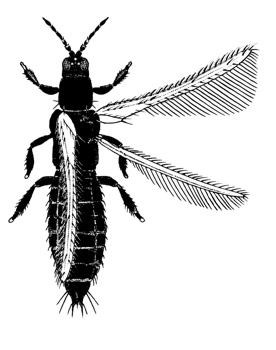Pests
Thrips linarius Uzel - Flax Thrips
Systematic position.
Class Insecta, order Thysanoptera, suborder Terebrantia, family Thripidae, genus Thrips L. Closely related to Thrips angusticeps Uzel, differing in number of hairs on posterior margin of pronotum and in color of antennae.Biological group.
Pest of flax (Linum usitatissimum L.).Morphology and biology.
Body length of female, 0.9-1.0 mm. Body dark-brown, almost black. Head with ocellar triangle between compound eyes. Piercing and suctorial type of mouthpart. Antennae 7-segmented, mostly black, apical part of the 2nd and 3rd segments yellowish, 4th segment as long as 3rd and longer than 5th, 7th segment narrow. Pronotum with 3 pairs of posteromarginal setae. Forewings narrow, acute apically, slightly darkened, without transversal veins, the 1st vein with 3 setae in distal part. Only macroptera form is known. Abdomen widened. Legs black, only fore tibia yellowish, with somewhat darkened anterior surface. Femur toothless, tarsus 2-segmented, with tarsal bladder at apex. Ovipositor curved downward. Male smaller than female and lighter in color. Ventral surface of 2nd-6th segments of abdomen with transparent ellipsoidal spots. Incomplete type of metamorphosis; the life cycle consists of stages of egg, first and second instar larva, propupa, pupa, and adult. Egg transparent-whitish, 0.3 mm. Larvae transparent after hatching, then yellowish in color; lateral surface of pronotum darkened; meso- and metanotum with black spots. Antennae short, 3rd and 4th segments thickened. Length of mature larvae, 0.9 mm. Propupa yellowish; its wing pads transparent; antennae directed anteriad. Pupa the same in color; its wing pads longer; antennae 7-segmented, directed backward.Distribution.
The species is distributed in Europe and Northern Africa. In the former USSR the area of Flax Thrips coincides with the territory of flax growing from western state borders eastward to Krasnoyarsk Territory.Ecology.
Monovoltine species. Adults hibernate in fields, in soil at a depth of 20-40 cm. Mass appearance of adult occurs in spring, at temperature about 20°C at a depth 20 cm, and then mating begins. In spring adults appear on weeds for the first time. Generally, only females fly in search of flax fields. Imagoes concentrate near stem growing-point and under sepals of buds and ovaries. Females lay eggs in slits cut with the ovipositor into the apical part of host, around base of leafstalk and into buds. Fertility is near 80 eggs. One generation develops 42-46 days: egg develops 5 days, larva - 23-25 days. After feeding on the flax larva drops to the ground and pupates in the soil at a depth 10-25 cm into the small chamber. After emergence adults stay in the ground before the next spring. Population density of thrips in nature depends on the activity of predators, e.g.: larvae of Aeolothrips fasciatus L.Economic significance.
Larvae and adults are harmful. Infested plants delay in growth; length of productive part of stem decreases, leaves convolve, buds drop, bolls dehisce, amount of seeds decreases. Depressed plants are populated with fungi. Control measures against the T. linarius include deep autumn plowing, crop rotation of flax and clover or fallow, increase of seeding rate, using of fertilizations for the development acceleration of seedlings and sowing the flax at the earliest time.Related references:
Bonnemaison, L. & Bournier, A. 1964. Les thrips du lin [Flax Thrips]: Thrips angusticeps Uzel et Thrips linarius Uzel (Thysanopteres). Annales des Epiphyties (Paris) 15(2): 97-169 (In French).Ermolaev, M.S. 1940. The biology of Thrips linarius Uz. and its control. Bulletin of plant protection (Moscow & Leningrad) 3: 23-34. (In Russian).
Gentile, A.G. & Bailey, S.F. 1968. A revision of the genus Thrips Linnaeus in the New World with a catalogue of the world species (Thysanoptera: Thripidae). Berkeley & Los Angeles: University of California publications in entomology, V. 51, 95 p.
Nakahara, S. 1994. The Genus Thrips Linnaeus (Thysanoptera: Thripidae) of the New World. Washington: United States Department of Agriculture, Agricultural Research Service. Technical Bulletin. N 1822, 183 p.
Tanskii, V.I. & Velikan', V.C. 1981. Order thrips - Thysanoptera. In: Kopaneva, L.M., ed. Keys to harmful and useful insects and mites on the industrial crops in the USSR. Leningrad: Kolos. P. 64-70. (In Russian).
Yakhontov, V.V. 1964. Order Thysanoptera - thrips. In : Bei-Bienko, G.Ya., ed. Keys to the insects of the European part of the USSR. V. 1. Moscow & Leningrad: Nauka. P. 846-874 (In Russian).
Zhil'tsova, L.A. & Derbeneva, N.N. 1972. Order Thysanoptera - thrips. In: Kryzhanovskii, O.L. & Danzig, E.M., eds. Pest insects and mites of agricultural plants. Insects with hemimetabolous development. V. 1. Leningrad: Nauka. 323 p. (In Russian).


